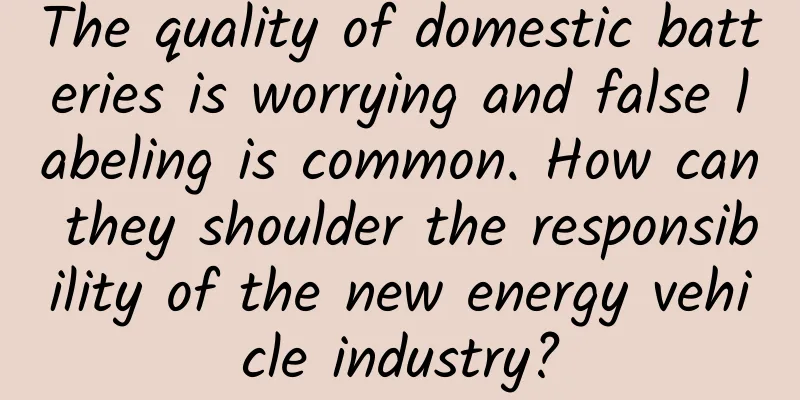The quality of domestic batteries is worrying and false labeling is common. How can they shoulder the responsibility of the new energy vehicle industry?

|
WM Motor, which is about to deliver in September, recently received bad news - on August 25, a WM Motor car caught fire. WM Motor said that the car that caught fire was an early test vehicle that had been scrapped and entered the dismantling process. Because the employees violated regulations and powered on the scrapped vehicle, they triggered the risk of short circuit in the vehicle, causing the battery pack to catch fire. In this regard, some netizens questioned why scrapped vehicles were dismantled outdoors on the roadside? When dismantling the vehicles, why didn't they remove the batteries first but the protective devices first? Some media inferred from the accident vehicle number and production date that the relevant batteries were provided by Zhejiang Gushen. However, Gushen later denied it in an open letter. The truth needs further investigation. However, the safety of power batteries concerns the life safety of consumers, and the quality of domestic power batteries is worrying. According to foreign media reports, General Motors' plan to produce the Buick Velite 6 plug-in hybrid vehicle had to be postponed because the batteries provided by A123 Technologies did not meet General Motors' high quality requirements. A123 Technologies is headquartered in the United States and was acquired by China's Wanxiang Group in 2013. The company has built a battery production plant in China to produce power batteries for the domestic market. General Motors is currently in a dilemma: it must use domestically produced batteries, but at the same time it cannot sacrifice technical standards. The spontaneous combustion of WM Motor’s batteries and General Motors’ lack of batteries that meet the standards have exposed the shortcomings of my country’s power battery industry. Domestic power batteries with a habit of false labeling In 2017, CATL surpassed Panasonic to become the company with the highest power battery shipments in the world. In 2017, among the top 10 companies in the world in terms of power battery sales, 7 were Chinese companies. China has surpassed Japan and South Korea in the power battery market share and has become the world's number one. According to statistics, there are more than 200 battery manufacturing companies in my country, making it the country with the largest number of lithium battery companies in the world. Although the scale of my country's power battery industry is already the largest in the world, we must also recognize that my country's power battery industry is still big but not strong. As of 2017, China's cumulative ownership of new energy vehicles reached 1.8 million, accounting for more than 50% of the global market. In the first seven months of 2018, my country's new energy vehicle sales approached 500,000 units, a year-on-year increase of 97.1%. Although China has a high sales volume of electric vehicles, most of them are low-end models, and the overall requirements for batteries are relatively low. Accordingly, domestic battery manufacturers do not have very strict quality standards for batteries. Since the beginning of this year, multinational automakers such as Nissan, Toyota, and Volkswagen have announced their respective new energy vehicle plans in China. Starting from the second half of this year, many multinational automakers will successively launch pure electric and plug-in hybrid models in the Chinese market. With the increasing expansion of the electric vehicle market and the country's increasingly relaxed policies on foreign investment in the production of new energy vehicles in China, more and more multinational automakers will build factories in China to produce new energy vehicles in the future. This will not only bring impacts to domestic brand new energy vehicles, but also bring opportunities to domestic battery companies. However, most of the electric vehicles produced by these multinational automakers are mid-to-high-end models, and the quality requirements for batteries are also relatively high. Whether domestic battery companies can seize this market opportunity remains an unknown. The new models launched in 2018 have a range of 400 kilometers in many operating conditions. However, there is a lot of water in this rapidly increasing range. Many car companies put the operating range in the name of their models, such as Geely Emgrand EV450, BYD Qin EV450, and Denza 500, but many car companies deliberately exaggerate the numbers. For example, the comprehensive operating range of Jiangling E400 is only 252 kilometers, and the comprehensive operating range of SAIC EV400 is only 320 kilometers. The actual range will only be lower than the comprehensive operating range. In contrast, the mileage advertised by Tesla is not much different from the actual driving data. You know, the battery is the key factor affecting the actual mileage. The actual mileage of domestic energy vehicles is insufficient, and at least half of the blame should be borne by power battery companies. In 2017, the top ten global power battery companies in terms of sales volume were all from China, Japan and South Korea. It seems that the power battery industry has become the world of the three countries. In fact, although there are not many power battery companies in the United States, it is still leading the technological development of the power battery industry. The United States has strong R&D and design capabilities in the power battery industry and is in a leading position in the original innovation of lithium batteries and the research and development of core materials. The core patents of the most cutting-edge ternary materials for lithium batteries are still in the hands of 3M and Argonne National Laboratory in the United States. At present, mainstream manufacturers such as Panasonic, Samsung, and LG have to purchase relevant patent licenses. my country's lithium battery research in basic materials is still far behind the world's leading level. For example, the diaphragm required for power battery production is still a shortcoming of the domestic battery industry. Domestic diaphragms are mainly supplied to the low-end battery market, and high-end diaphragms are still largely dependent on imports. This limits the improvement of the overall level of China's power battery industry and has become an obstacle for domestic power batteries to "go global". The domestic power battery industry is in crisis At present, ternary batteries have gradually replaced lithium iron carbonate batteries and become the mainstream batteries used in passenger cars due to their advantages in energy density. However, the energy density of ternary batteries is still relatively low, which is not enough to eliminate the range anxiety of electric vehicles. Ternary materials are layered nickel-cobalt-manganese oxide composite materials. According to the ratio of nickel, cobalt and manganese, ternary materials can be divided into 111, 523, 622, 811, etc. Since the main function of nickel is to increase energy density, 811 high-nickel batteries have become the current research and development focus. China has fallen behind in this field. BYD and CATL both plan to launch 811 high-nickel batteries next year. Panasonic's high-nickel ternary power batteries have been used in Tesla Model 3. Panasonic has improved the application of high-nickel positive electrode materials and silicon-carbon negative electrode materials to increase battery energy density by 20%. Although China is temporarily leading in power battery shipments, if it fails to catch up in the field of 811 high-nickel ternary batteries, its market share will face the risk of shrinking significantly. Since pure electric vehicles are still far behind fuel vehicles in terms of cruising range, the energy density of power batteries is the key to improving cruising range. Technological innovation is far from over and the entire power battery industry is still full of variables. Fisker, an American electric car startup, has been developing solid-state batteries on its own. Recently, Fisker announced that its self-developed solid-state lithium-ion battery will be mass-produced within a few months. Once this battery with short charging time and long battery life is applied, it is likely to bring new impact to the power battery industry. In June this year, the New Energy and Industrial Technology Development Organization of Japan will jointly develop solid-state batteries with 23 automobile, battery and material companies including Toyota, Honda, Nissan and Panasonic, and plans to fully master the relevant technologies of solid-state batteries by 2022. Europe is also unwilling to give up this field. Volkswagen plans to independently produce solid-state batteries in Europe by 2024. The risks for power battery companies not only come from new technologies, but car companies are also trying to build their own battery factories to reduce their dependence on power battery companies. At the end of July, Germany's Daimler Group announced an investment of 500 million euros to build a second battery factory in Germany. Toyota and Tesla are also planning to add battery factories. Not only multinational auto giants, but also some domestic automakers are building their own battery factories. While Geely is buying batteries from LG, it is also building its own battery factory in Shandong. Batteries account for about half of the cost of electric vehicles. For automakers, building their own battery factories can reduce R&D costs and facilitate the integration of their own product lines. In this way, the pie of power battery companies is bound to be touched. Around 2015, Japanese and Korean battery companies entered China one after another, trying to seize the market with low prices, but eventually withdrew from China due to factors such as subsidies. After 2020, subsidies will be completely withdrawn, and Japanese and Korean battery companies will make a comeback, and they have already begun to prepare. In April 2018, the China Association of Automobile Manufacturers released the first white list of the power battery industry, which included many foreign-funded enterprises such as Samsung Huanxin (Xi'an) Power Battery Co., Ltd., Nanjing LG Chemical New Energy Battery Co., Ltd., and Beijing Electric Control Aisike Technology Co., Ltd. On July 17, LG Chem officially signed a contract in Nanjing to invest US$2 billion to build a power battery project. The project will start in October this year and start mass production in October 2019. Recently, subsidies for new energy vehicles have gradually declined, and power battery companies as upstream companies have been deeply affected. Some companies that expanded blindly and made mistakes in choosing technical paths have already exited the market, and many companies are still struggling. In July, CATL ranked first with an installed capacity of 1.276Gwh, accounting for 37.9% of the total installed capacity in July. In the first half of the year, CATL's total operating income was 9.36 billion yuan, a year-on-year increase of 48.69%, while its profit fell by 49.70%. Even the leading companies in the industry are like this, and domestic power battery companies seem to have encountered a bottleneck period. Despite so many problems, China's power battery industry is no longer a fledgling industry and has laid a good foundation. There are still many variables in the future of the power battery industry, which also means more opportunities and challenges. The participation of Japanese and Korean companies and the high demands of multinational auto giants on battery quality have forced domestic battery companies to no longer be satisfied with the success under policy protection, but to join the fierce international market competition. Only when domestic power batteries occupy the high-end battery market and win the competition in the international market can they truly take on the important task of overtaking in the automotive industry. As a winner of Toutiao's Qingyun Plan and Baijiahao's Bai+ Plan, the 2019 Baidu Digital Author of the Year, the Baijiahao's Most Popular Author in the Technology Field, the 2019 Sogou Technology and Culture Author, and the 2021 Baijiahao Quarterly Influential Creator, he has won many awards, including the 2013 Sohu Best Industry Media Person, the 2015 China New Media Entrepreneurship Competition Beijing Third Place, the 2015 Guangmang Experience Award, the 2015 China New Media Entrepreneurship Competition Finals Third Place, and the 2018 Baidu Dynamic Annual Powerful Celebrity. |
>>: In July, Tesla surpassed BYD and BAIC Motor topped the global electric vehicle sales chart
Recommend
When will the Shanghai epidemic end in 2022? What is the latest list of gated communities? Details attached!
The recent local epidemic in Shanghai has become t...
How to operate a new product from 0 to 1!
When operating a new product, there are many thin...
Starting from the rectification of large-screen TV operations, China's color TV industry looks forward to 2024 on the cusp of technology
More than a decade ago, smart TVs were once very ...
E-commerce operations: How to price products?
Let’s start by answering the first question: Why ...
Will taking a bath or exercising after having sex make the condition worse? Many people ignore these 4 things
I avoided the first day but couldn't avoid th...
Resistant to 500℃ high temperature! New ultra-strong carbon plastic makes up for the "weak rib" of aerospace manufacturing?
Author: Huang Xianghong Duan Yuechu In today'...
Why is the meat of mantis shrimp so delicious? It turns out that it is trained through "boxing"!
Review expert: Liang Yujun, Associate Professor, ...
From 10,000+ global user reviews, I found these 6 points
Do you think that user reviews of apps are valuab...
E-commerce operations: coupon product analysis
On e-commerce platforms, issuing coupons is a ver...
Taobao Live Competitive Product Analysis and Optimization Strategy
In recent years, the integration of live streamin...
With the first flight of a low-sounding aircraft imminent, is supersonic travel just around the corner?
The X-59 is a unique experimental aircraft. It is...
Who sets the shelf life of food? Can you still eat food one day past the expiration date?
Everyone knows what the expiration date of food i...
BlackBerry Priv review
On November 13, BlackBerry held a new product lau...
Zhihu ranking algorithm and traffic diversion method
The following content is the editor’s exclusive e...
The dramatic changes in consumption behind the passionate festivals created by home appliance giants
JD.com's 618 promotion has just ended, Suning...









